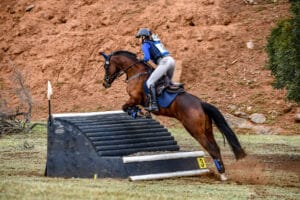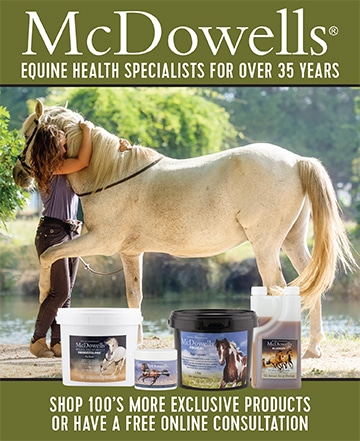Training for cross country isn’t all galloping hell for leather over big fences; neither is it perfect distances and stride control. In this article, 5* eventer Sarah Clark breaks down the fundamentals of training and riding cross country that will stand you and your horse in good stead – regardless of your level or experience.
1. Train your horse to think for itself while listening to you
While it may sound contradictory, the essence of a good cross country partnership is teaching the horse to think for itself while listening its rider.
Sarah explains that on cross country, neither horse nor rider gets it right 100% of the time, and so sometimes the rider needs to get a horse out of trouble or vice versa. That’s why it’s important the horse is taught to use its initiative and develop its sense of self-preservation, rather than being dictated to. At the same time, it must also listen to the rider as it hasn’t walked the course.
That way it becomes a partnership as opposed to a dictatorship.
2. The horse is responsible for its footwork; the rider is responsible for pace and line
To train based on the first principle, keep in mind that the horse must figure out where to put his feet, while maintaining the pace and line determined by the rider.
Good footwork can be developed by riding over different terrain and lines, and will be covered further in the next two articles.
As well as deciding the line and pace, as a rider you need to work on developing the ability to feel what’s happening and reacting quickly. This comes from time and experience and getting to know your horse, so that you can know what’s going to work in a situation and respond instinctively. As much as you are teaching horse to figure out their feet, you can’t remain a passenger – you have to learn to see when to push and when to wait.
3. Correct – don’t hold –the horse’s line
In cross country, it’s essential you are on a very accurate line to each fence, which is why you should train your horse to always maintain the line you ride it on.
In keeping with the first two points, this means getting your horse to correct its line by responding to your aids, as opposed to manhandling the horse into straightness.
Sarah has two tips for riding for accuracy in this manner. Firstly, she envisions a red string from her eyes onto the intended path over the fences, and her horse has to stay on it. This is especially useful when training and riding over tricky lines, but should be used all the time to build the practice from the beginning.
Secondly, she imagines her legs and hands are bumpers like those in bumper bowling. When the horse tries to deviate from the line, it simply hits the left or right bumper and so it has to stay in the middle. This avoids fighting the horse onto the line or overcorrecting.

4. Take things slowly to maintain the pace
With all the adrenaline that cross country brings, how do you teach your horse to maintain the pace that you decide? Sarah is a big believer in doing things slowly from start, so the horse takes the time to figure out questions and carry them out because they understand them, not because of adrenaline. Always walk obstacles like ditches, banks, and water on a long rein so the horse understands them instead of getting over them with speed.
Sometimes the excitement takes over anyway, in which case it’s important to be consistent in correcting any changes in pace. Sarah uses a lot of halts in her training – four strides before or after the fence – to make sure the horse is listening and to de-fuse any tendency to rush.
Even in the competition warmup that consistency is essential. Don’t be afraid to take a step back and approach some fences in trot or add in some halts if your horse is getting excited.
5. Start cross country basics early in the horse’s training
Sarah says that people underestimate just how simple cross country schooling can be. As soon as you have stop, go and turn, you can begin training the basics.
Sarah works her young horses over poles spread at random across the arena, teaching the horse to follow the line and go over what’s in front of them, regardless of whether it’s straight or on an angle. She also recommends taking the time to walk your horse on a long rein up and down hills, over streams, puddles, fallen branches, and so on. Let the horse find their way through and over, to learn coordination of their feet and using their head and neck to help balance.
6. It doesn’t have to be picture perfect
Sarah says it’s much more important to learn how to survive a hairy moment than it is to be picture perfect. Even the best in the world make mistakes, and it’s learning how to get out of these that make capable cross country riders and horses.
This includes seeing a distance. Sarah says don’t feel like you have to see a perfect stride all the time – instead put emphasis on your pace and line. As long as your horse has impulsion and is in the right balance, he can get himself out of remarkable situations.
7. Build the positive experience bank
While hairy moment doesn’t mean a bad cross country school or a terrible round, the key is to build back the horse’s confidence with a positive experience.
Sarah says to think of it like a positive experience bank. Every good jump puts money in the bank, and every not so good jump takes money out. Whether you’re training or out on course, you want to make sure you’re always in surplus – if you have a sticky moment, put it behind you and focus on putting more money into the bank with a confident ride to your next jump.

In the next article we will look at how to train good footwork, line and pace for cross country using exercises on the arena.


